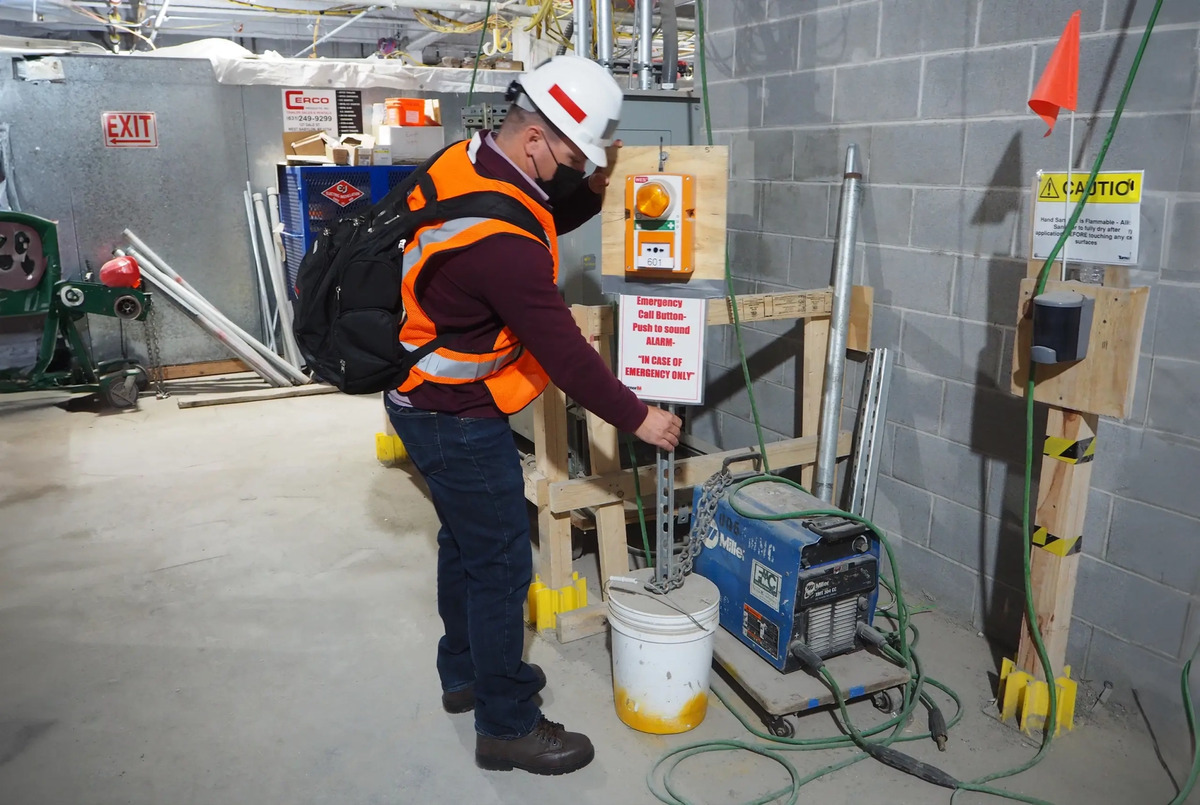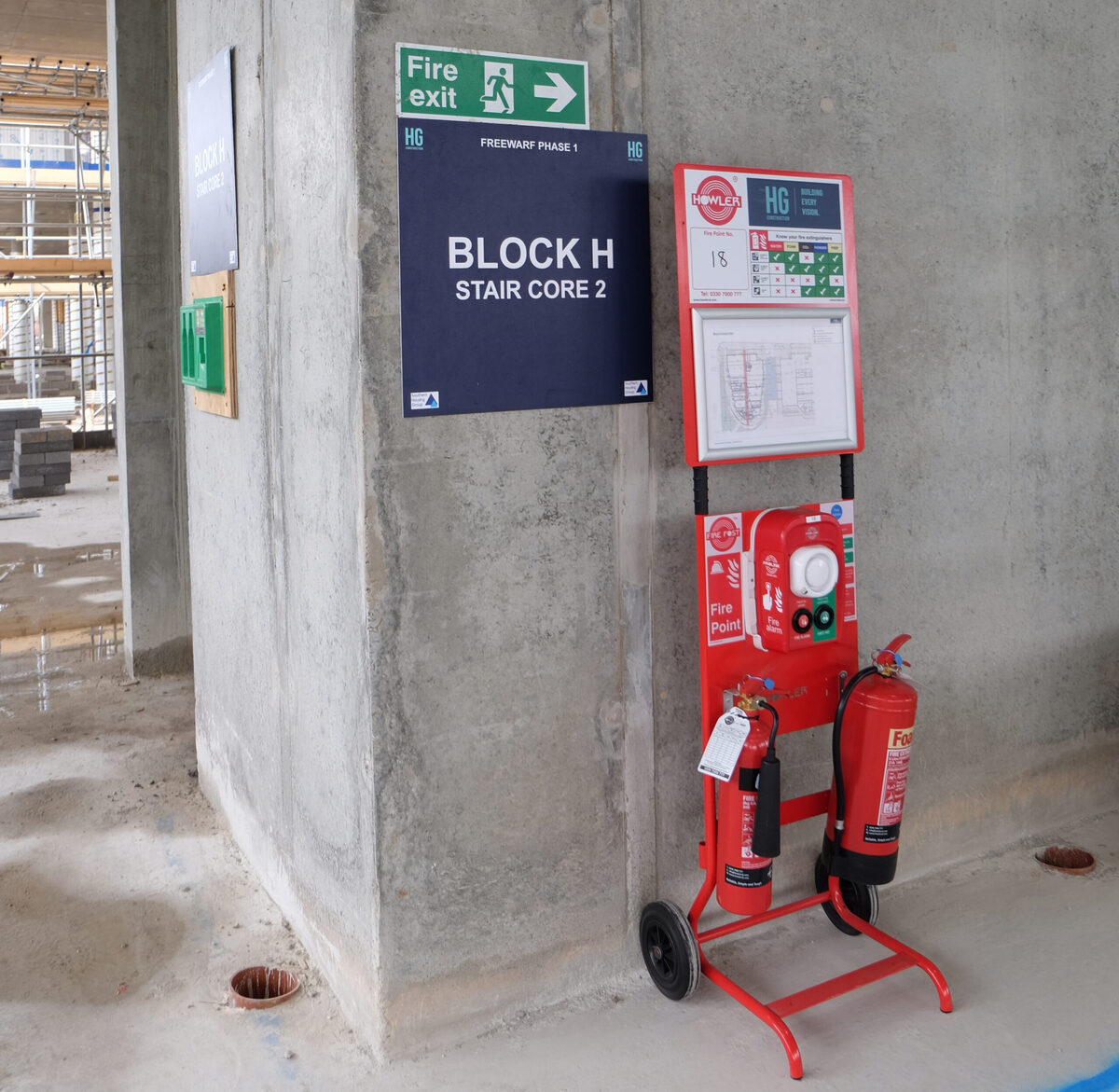Updated by Nazanin Ghodsian, 08/19/2024
Construction sites are dynamic environments characterized by a multitude of hazards and risks, implementing robust emergency alarm on construction site and comprehensive training programs essential for safeguarding the construction site safety and well-being of workers. According to the U.S. Bureau of Labor Statistics, the construction industry consistently ranks among the top sectors with the highest rates of workplace injuries and fatalities. In fact, in 2020 alone, there were approximately 1,102 fatal injuries reported in the construction industry, highlighting the urgent need for effective emergency preparedness measures.
To prevent fatalities and control the hazards associated with fires, gas leaks, medical emergencies, and structural failures, emergency alarm on construction sites are essential. These systems function as the first line of defense, offering early detection and immediate notification to enable prompt responses that can avert serious incidents and safeguard employees.
In this article, we will look into the different kinds of emergency alarm on construction site, explore their importance, and go over the key elements that make up these critical systems. Additionally, in order to guarantee efficient emergency preparedness, we will emphasize best practices for handling emergency alarm responses on building sites.
Table of Contents
Types of Emergency Alarm in Construction Sites
Here are the types of emergency alarm on construction site:
- Fire Alarms:
- This emergency alarm on construction site detect smoke, heat, or flames and alert occupants to the presence of a fire.
- They can be manual (activated by a person) or automatic (triggered by sensors).
- Fire alarms are crucial for rapid evacuation and preventing fire-related injuries and fatalities.
- Gas Leak Alarms:
- Gas leak emergency alarm on construction site detect the presence of hazardous gases such as methane, propane, or carbon monoxide.
- They provide early warning of potential gas leaks, which can lead to explosions, asphyxiation, or other serious hazards.
- Gas leak alarms are essential for maintaining a safe working environment in areas where gas-powered equipment is used or where natural gas pipelines are present.
- Medical Emergency Alarms:
- These alarms are activated in the event of a medical emergency such as a heart attack, stroke, or serious injury on the construction site.
- Medical emergency alarm on construction site enable swift response from trained personnel or emergency medical services (EMS) to provide immediate assistance to the injured individual.
- They are critical for minimizing the impact of medical emergencies and saving lives.
- Structural Failure Alarms:
- Structural failure alarms detect signs of structural instability or collapse in buildings or construction structures.
- This emergency alarm on construction site may monitor factors such as movement, vibration, or stress levels in the structure.
- Early detection of structural issues can prevent accidents and injuries by prompting evacuation or reinforcement measures.
- Weather-related Alarms:
- Weather-related alarms alert workers to severe weather conditions such as thunderstorms, tornadoes, or hurricanes.
- This emergency alarm on construction site provide advance warning, allowing workers to seek shelter and take appropriate safety precautions.
- Weather-related alarms are essential for protecting workers from injury or death due to extreme weather events.
- Intruder Alarms:
- Intruder alarms are designed to detect unauthorized access to the construction site, such as break-ins or trespassing.
- This emergency alarm on construction site can include motion sensors, perimeter fencing sensors, or CCTV surveillance systems.
- Intruder alarms help prevent theft, vandalism, and other security breaches, enhancing site safety and security.
- Hazardous Material Release Alarms:
- Hazardous material release alarms are activated when there is a spill, leak, or release of dangerous substances such as chemicals, toxins, or radioactive materials.
- These alarms alert workers to evacuate the area immediately and implement containment measures to prevent exposure and environmental contamination.
- Hazardous material release alarms are crucial for protecting both workers and the surrounding environment from the harmful effects of chemical or biological hazards.
- Confined Space Alarms:
- Confined space alarms are used in areas with limited access or restricted ventilation, such as trenches, pits, or underground chambers.
- This emergency alarm on construction site monitor air quality parameters such as oxygen levels, toxic gas concentrations, and atmospheric pressure.
- Confined space alarms provide early warning of hazardous conditions, allowing workers to evacuate safely or use appropriate respiratory protection equipment.
- Fall Detection Alarms:
- Fall detection alarms are worn by workers and are designed to automatically trigger an alarm in the event of a fall or sudden impact.
- These alarms may utilize accelerometers, gyroscopes, or pressure sensors to detect falls and send distress signals to nearby personnel or a central monitoring station.
- Fall detection alarms help reduce response time in the event of an accident and improve the chances of prompt medical assistance for injured workers.
- Power Failure Alarms:
- Power failure alarms activate when there is a loss of electrical power supply to essential systems or equipment on the construction site.
- This emergency alarm on construction site can alert personnel to potential safety hazards, such as malfunctioning machinery or loss of lighting in critical areas.
- Power failure alarms facilitate the timely restoration of power and the implementation of backup systems to maintain site operations and safety.
Suggested article to read: Construction Safety Sensors; Guide to 2024 | Safety First (2024): Enhancing AI and Sensors in Construction Safety
Each type of emergency alarm on construction site plays a crucial role in safeguarding the lives and well-being of construction site personnel and visitors. Integrating multiple alarm systems and ensuring regular maintenance and testing are essential for effective emergency preparedness and response.

Importance of Emergency Alarm on Construction Site
The importance of emergency alarm on construction sites cannot be overstated. These systems serve as critical components of safety protocols, offering numerous benefits:
- Early Detection and Notification: Emergency alarm systems are designed to detect potential hazards or emergencies at their onset. Whether it’s a fire, gas leak, medical emergency, or structural failure, these alarms provide early warning, allowing workers to take immediate action to mitigate risks and evacuate if necessary. Early detection significantly reduces response time, helping to prevent injuries, fatalities, and property damage.
- Rapid Response: Once an emergency alarm on construction site is activated, it triggers a swift response from site personnel and emergency services. This rapid response is crucial for containing the situation, minimizing its impact, and ensuring the safety of everyone on the construction site. Prompt action can make a significant difference in the outcome of an emergency scenario.
- Worker Safety: The primary purpose of emergency alarm on construction site is to protect the safety and well-being of construction site workers. By alerting them to potential dangers, such as fires, gas leaks, or structural failures, these systems enable workers to evacuate to safety zones or take appropriate precautions to avoid harm. This proactive approach reduces the likelihood of injuries or fatalities in hazardous situations.
- Property Protection: Emergency alarm on construction site not only safeguard human lives but also help protect property and assets on construction sites. Early detection of fires, intrusions, or hazardous material releases allows for prompt intervention to prevent or minimize damage to buildings, equipment, materials, and infrastructure. This ultimately reduces the financial losses associated with emergencies and disruptions to construction projects.
- Regulatory Compliance: Compliance with safety regulations and standards is essential for construction sites to operate legally and responsibly. Many jurisdictions require the installation of emergency alarm on construction site as part of safety regulations enforced by organizations such as the Occupational Safety and Health Administration (OSHA). By implementing these systems, construction companies demonstrate their commitment to compliance and prioritize the safety of their workers.
- Peace of Mind: Having robust emergency alarm systems in place provides peace of mind to workers, supervisors, and stakeholders involved in construction projects. Knowing that there are measures in place to detect and respond to emergencies effectively instills confidence and reassurance in the overall safety protocols of the site.
Emergency alarm on construction site play a vital role in ensuring the safety, security, and regulatory compliance of construction sites. Their early detection capabilities, coupled with rapid response protocols, help mitigate risks, protect lives and property, and promote a culture of safety within the construction industry. Investing in high-quality emergency alarm systems is an essential aspect of comprehensive risk management for construction projects of any scale or complexity.
Suggested article to read: Top 11 Construction Safety Tips for 2024 | Enhancing Safety by Co-Pilot for Construction Technology (2024)
Components of an Emergency Alarm System
An emergency alarm on construction site typically comprises several interconnected components working together to detect, signal, and respond to emergencies effectively. These components may vary depending on the specific hazards present on the site and the regulatory requirements. Here are the essential components of an emergency alarm system:
- Sensors and Detectors:
- Smoke Detectors: These devices detect the presence of smoke particles in the air, signaling a potential fire.
- Heat Detectors: Heat detectors sense rapid temperature increases, indicating a fire outbreak.
- Gas Detectors: Gas detectors monitor the air for the presence of hazardous gases such as carbon monoxide, methane, or propane.
- Motion Sensors: Motion sensors detect movement within specific areas and can be used for intruder detection or fall detection.
- Control Panel:
- The control panel is the central hub of the emergency alarm on construction site, where signals from sensors and detectors are received and processed.
- It controls the activation of alarm devices and communicates with external monitoring stations or emergency services.
- The control panel may feature indicators, displays, and interfaces for system configuration and diagnostics.
- Alert Devices:
- Sirens: Sirens emit loud audible alarms to alert occupants of the construction site to an emergency.
- Strobes: Strobe lights produce bright, flashing lights to provide visual alerts, particularly in noisy environments or for individuals with hearing impairments.
- Horns: Horns or klaxons generate distinctive sound patterns to attract attention during emergencies.
- Speakers: Speaker systems broadcast voice messages or pre-recorded announcements to convey emergency instructions or evacuation procedures.
- Communication Systems:
- Two-Way Radios: Two-way radios enable real-time communication between construction site personnel, supervisors, and emergency responders.
- Intercom Systems: Intercoms allow for direct communication between different areas of the construction site or between workers and control centers.
- Telephone Lines: Dedicated telephone lines or cellular communication devices facilitate communication with emergency services and off-site stakeholders.
- Power Supply and Backup:
- The emergency alarm on construction site relies on a reliable power supply to operate effectively.
- Backup power sources such as batteries or generators ensure that the system remains functional during power outages or failures.
- Monitoring and Reporting:
- Monitoring Stations: Centralized monitoring stations receive alerts from the emergency alarm on construction site and coordinate responses, including dispatching emergency services if necessary.
- Remote Monitoring: Some systems may feature remote monitoring capabilities, allowing authorized personnel to monitor the status of the system and receive alerts via mobile devices or computers.
- Integration with Building Systems:
- Integration with other building systems, such as HVAC (Heating, Ventilation, and Air Conditioning) and access control, enhances the overall effectiveness of the emergency alarm on construction site.
- Integration allows for coordinated responses to emergencies, such as shutting down ventilation systems to prevent smoke spread or unlocking doors for evacuation routes.
- Testing and Maintenance Equipment:
- Testing and maintenance equipment, such as smoke aerosol testers and gas calibration kits, ensure the ongoing reliability and performance of the emergency alarm in construction site.
- Regular testing, inspection, and maintenance are essential to identify and address any issues promptly and to comply with regulatory requirements.
By incorporating these components into an integrated emergency alarm on construction sites can effectively detect, communicate, and respond to emergencies, enhancing the safety and security of workers and occupants. Regular training, drills, and system maintenance are critical to ensuring the system’s continued effectiveness and reliability.
Suggested article to read: Construction Monitoring Solutions: Your Complete Guide | Technologies Transforming Construction Monitoring; 2024 Review
Responding to Emergency Alarms
Responding to emergency alarm on construction site requires a coordinated and decisive approach to ensure the safety and well-being of everyone involved. Here’s a step-by-step guide on how to respond effectively to various types of emergency alarm on construction site:
- Immediate Actions Upon Hearing the Alarm:
- Take the alarm seriously: Upon hearing the emergency alarm on construction site, assume that there is a genuine emergency and respond promptly.
- Do not ignore the alarm or assume it is a false alarm without verification.
- Stop all work activities immediately and focus on emergency procedures.
- Assess the Situation:
- Remain calm and assess the nature of the emergency based on the type of alarm activated (e.g., fire alarm, gas leak alarm).
- Look for signs of smoke, fire, gas leaks, structural damage, or other hazards that may require immediate action.
- Evaluate the extent of the emergency and the potential impact on personnel, equipment, and property.
- Follow Established Emergency Procedures:
- Follow the established emergency procedures specific to the type of alarm activated.
- Refer to the site’s emergency response plan, which should outline detailed procedures for various emergency scenarios.
- Communicate with coworkers and ensure everyone understands their roles and responsibilities during the emergency.
- Evacuation Procedures:
- If evacuation is necessary, follow predetermined evacuation routes and assembly points.
- Assist any individuals who may require help evacuating, such as injured or disabled coworkers.
- Do not use elevators during evacuations; use stairwells instead.
- Evacuate to a safe location outside the construction site and await further instructions.
- Contact Emergency Services:
- If the situation warrants it, contact emergency services (fire department, ambulance, etc.) immediately.
- Provide relevant information about the nature of the emergency, the location of the construction site, and any specific hazards present.
- Follow any instructions given by emergency services personnel and provide assistance as needed.
- Account for Personnel:
- Conduct a headcount to ensure that all construction site personnel have evacuated safely.
- Use attendance lists or check-in procedures to verify that everyone is accounted for.
- Report any missing or unaccounted-for individuals to emergency responders.
- Follow-Up Actions:
- Once the emergency has been resolved, conduct a debriefing to review the response and identify any areas for improvement.
- Document the incident, including actions taken and lessons learned, for future reference and training purposes.
- Conduct any necessary post-emergency inspections or repairs to ensure the construction site is safe for resuming work activities.
- Training and Preparedness:
- Regularly train construction site personnel on emergency procedures and protocols.
- Conduct emergency drills and exercises to practice response actions and improve readiness.
- Review and update the emergency response plan as needed based on lessons learned and changes in site conditions.
By following these steps and maintaining a proactive approach to emergency preparedness, construction site personnel can effectively respond to emergency alarm on construction site and mitigate the risks associated with various emergency scenarios. Prioritizing safety, communication, and training is key to ensuring a swift and coordinated response to emergencies on construction sites.

Training and Preparedness
Training and preparedness are integral aspects of ensuring that construction site personnel are equipped to respond effectively to emergencies. Here’s a comprehensive guide on training and preparedness measures:
- Establish Comprehensive Training Programs:
- Develop comprehensive training programs that cover emergency procedures, hazard recognition, and response protocols.
- Provide initial training for all new employees and contractors, as well as regular refresher training for existing personnel.
- Tailor training sessions to address specific hazards present on the construction site, such as fire safety, fall prevention, and hazardous material handling.
- Include Hands-On Exercises and Drills:
- Conduct hands-on exercises and drills to simulate emergency scenarios and practice response actions.
- Incorporate realistic scenarios that challenge participants to apply their knowledge and skills in a dynamic environment.
- Rotate roles and responsibilities during drills to ensure that all personnel are familiar with their assigned tasks during emergencies.
- Utilize Simulation and Virtual Reality Training:
- Utilize simulation technologies and virtual reality in construction (VR) training modules to supplement traditional training methods.
- Virtual simulations can provide immersive experiences that replicate various emergency scenarios, allowing personnel to practice their response in a controlled environment.
- VR training can be particularly beneficial for high-risk situations or scenarios that are difficult to replicate in real-life drills.
- Provide Specialized Training for Emergency Response Teams:
- Designate and train a team of personnel to serve as emergency response coordinators or first responders.
- Provide specialized training for these individuals in areas such as first aid, CPR, fire suppression, and rescue techniques.
- Ensure that emergency response teams are familiar with the layout of the construction site, emergency equipment locations, and communication protocols.
- Foster Communication and Coordination:
- Emphasize the importance of clear communication and coordination among construction site personnel during emergencies.
- Establish communication protocols, including designated channels for emergency announcements and instructions.
- Encourage personnel to report potential hazards or safety concerns promptly and communicate effectively with supervisors and coworkers.
- Conduct Regular Safety Meetings and Toolbox Talks:
- Hold regular safety meetings and toolbox talks to discuss relevant safety topics, including emergency preparedness.
- Use these sessions to review emergency procedures, share lessons learned from past incidents, and reinforce safety best practices.
- Encourage open dialogue and participation from all personnel to foster a culture of safety and accountability.
- Provide Access to Resources and Information:
- Ensure that construction site personnel have access to resources and information related to emergency preparedness.
- Distribute emergency response plans, evacuation maps, and contact information for emergency services.
- Provide access to personal protective equipment (PPE), emergency supplies, and first aid kits at easily accessible locations throughout the construction site.
- Regularly Evaluate and Improve Training Programs:
- Continuously evaluate the effectiveness of training programs through feedback, assessments, and performance reviews.
- Identify areas for improvement and update training materials and procedures accordingly.
- Stay informed about new developments in safety technology, regulations, and best practices to ensure that training programs remain current and relevant.
Suggested article to read: 5 Workers Monitoring Solutions in Construction Industry | Challenges in Construction Monitoring and How to Overcome Them; 2024 Guide
By prioritizing training and preparedness measures, construction site personnel can develop the knowledge, skills, and confidence needed to respond effectively to emergencies and mitigate risks on the job. Investing in comprehensive training programs demonstrates a commitment to safety and helps create a culture of safety awareness and preparedness within the construction industry.
Conclusion
The effective implementation of emergency alarm on construction site, coupled with comprehensive training and preparedness measures, is paramount to ensuring the safety and security of construction sites. The variety of emergency alarms available, from fire and gas leak alarms to intruder and fall detection alarms, underscores the diverse range of hazards that construction workers may face. These alarms serve as critical early warning systems, allowing for swift responses that can mitigate risks, prevent injuries, and save lives.
Furthermore, the importance of emergency alarm on construction site extends beyond the immediate response to emergencies. They also facilitate regulatory compliance, protect property, and provide peace of mind to workers and stakeholders involved in construction projects. By integrating multiple alarm systems and maintaining regular training and drills, construction sites can foster a culture of safety and preparedness, empowering personnel to respond effectively to emergencies with confidence.
Ultimately, investing in robust emergency alarm on construction site and prioritizing training and preparedness measures is not only a legal and ethical responsibility but also a sound business decision. It enhances the overall resilience and sustainability of construction projects, safeguarding the well-being of workers and preserving the integrity of operations. As construction sites continue to evolve and face new challenges, maintaining vigilance in emergency preparedness remains essential for ensuring safe and successful outcomes.
FAQs
Why are Emergency Alarm Systems Crucial on Construction Sites?
- Answer: They guarantee regulatory compliance, protect workers and property, enable quick responses, give peace of mind, and provide early warnings to avert damage and injuries.
What are the Best Practices for Training and Preparedness on Construction Sites?
- Answer: Provide thorough training, do exercises, use reaction teams with specific training, set up communication procedures, have safety meetings, supply emergency supplies, and keep training updated.
How Should Personnel Respond to an Emergency Alarm on Construction Site?
- Answer: Put an end to work, evaluate the situation, obey instructions, evacuate along approved routes, get in touch with emergency services, make sure everyone is safe, and then go over the event afterwards.
Suggested article for reading:
TokenMe: Monitoring Solution in Construction Industry
Understanding GDPR in Worker Monitoring (2024)
Resources:
Rogeer Williams University | HSE study guide | IOP Science | OSHA | safe Reach | Iowa State University
For all the pictures: Freepik | Ramtech Electronics | Howler UK





